Road Soultion of rail
15 April 2008

The most efficient way of moving new locomotives from their place of manufacture to a port for final shipment is, without doubt, by rail. Things change, however, when the track gauge of the receiving country, and by that of the locomotives to be moved, differs from that where the loco is made. In that case a different mode of transport has to be used to allow the manufacturer to successfully tender and complete a prestigious order. A recent example was supplying 16 locomotives to Vietnam Railways in an order worth ∈46 million.
Where inland waterways are unsuitable and both the weight and dimensions of a locomotive are critical to road transport, specialists have to be consulted to provide a professional, technically sound and legally acceptable transport method. In this case Siemens consulted Kübler, a specialist heavy transport company based in Schwäbisch Hall, Germany, to provide a solution.
Kübler has specialised in different types of heavy and or oversized load transport, including rail vehicles such as trams, subway trains and locomotives. Kubler's fleet even includes specially designed and custom built multi-purpose trailers and tools for moving rail vehicles.
The impressive details of the particular diesel-electric locomotive, the Asia Runner AR15VR, required Kübler specialists to carry out a detailed route survey and to match a suitable tractor-trailer combination to carry the load. The six-axle locomotive weighs about 81 tonnes and measures 19.80 m long, 2.82 m wide (excluding the lifting trunions) and is 3.95 m high.
Static load calculations of a number of highway bridges on the route revealed that gross vehicle weight would be critical. Therefore, to keep both the weight and height as low as possible, Kübler chose to use one of its vessel beds that can both be extended and hydraulically widened. To comply with the maximum axle loadings, the vessel bed would be configured between a set seven axle lines of Scheuerle Inter Combi hydraulic modular trailer at the rear and five axle lines, including a hydraulic neck and a four axle Titan tractor, at the front. In this way gross vehicle weight would be limited to an acceptable 179 tonnes.
Special preparation
With an overall length of 50.50 m, the tractor-trailer combination required careful handling and special precautions. Despite the steering axles the route leading from the factory to the highway had to be adapted in a number of ways. Trees had to be repositioned, as did a set of traffic lights and a street light. To leave the Siemens site and to reach public roads a special connecting road was created. At different locations the road had to be flattened for the load to pass.
In addition, the vessel bed required some modification. To allow the locomotive to be loaded in between both longitudinal beams that make up the vessel bed, the Kübler team designed and manufactured a set of cross beams that would allow each axle to be supported.
The detailed planning and preparations paid off when the first move was imminent. The Kübler crew assembled the vessel bed directly at Siemens' manufacturing location. Following that the 81 tonne locomotive was lifted in to the bed by overhead cranes. Manoeuvring the loaded trailer outside, on to Siemens' premises, proved to be a real challenge. The capabilities of an hydraulic trailer to independently steer the axles had to be used to manoeuvre outside. There awaited a number of other tight corners and manoeuvres before the locomotive reached the public road.
Again a complicated manoeuvre was required to access the autobahn highway system. Due to its length the tractor-trailer could not use the entrance road. Instead they backed up on to the autobahn by using the exit road. In the meantime police and road owners had temporarily closed the autobahn to all traffic. Once the tractor and trailer were premises, proved completely on the autobahn, the Kübler crew could continue their way forward, heading towards the port.
A number of times during that night traffic had to be stopped to allow the transport to pass over bridges alone because of the results from the previously mentioned bridge calculations that had been made.
Once the locomotive arrived in the port, it was lifted by a floating crane on to a heavy lift ship. The ship sailed for Haipong in Vietnam, where it discharged the locomotive straight on to the rails. In this way the Kübler team again safely deliveredto be real another complex load by using state of the art equipment in combination with experience and creative thinking.




